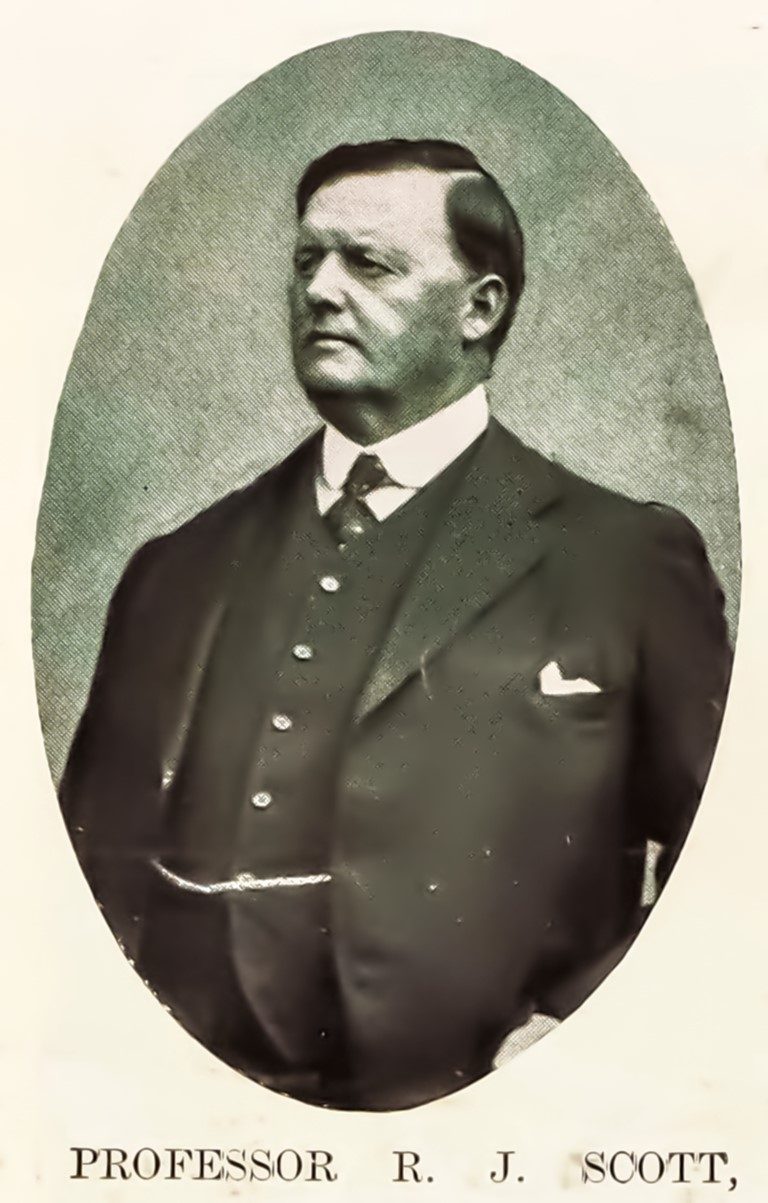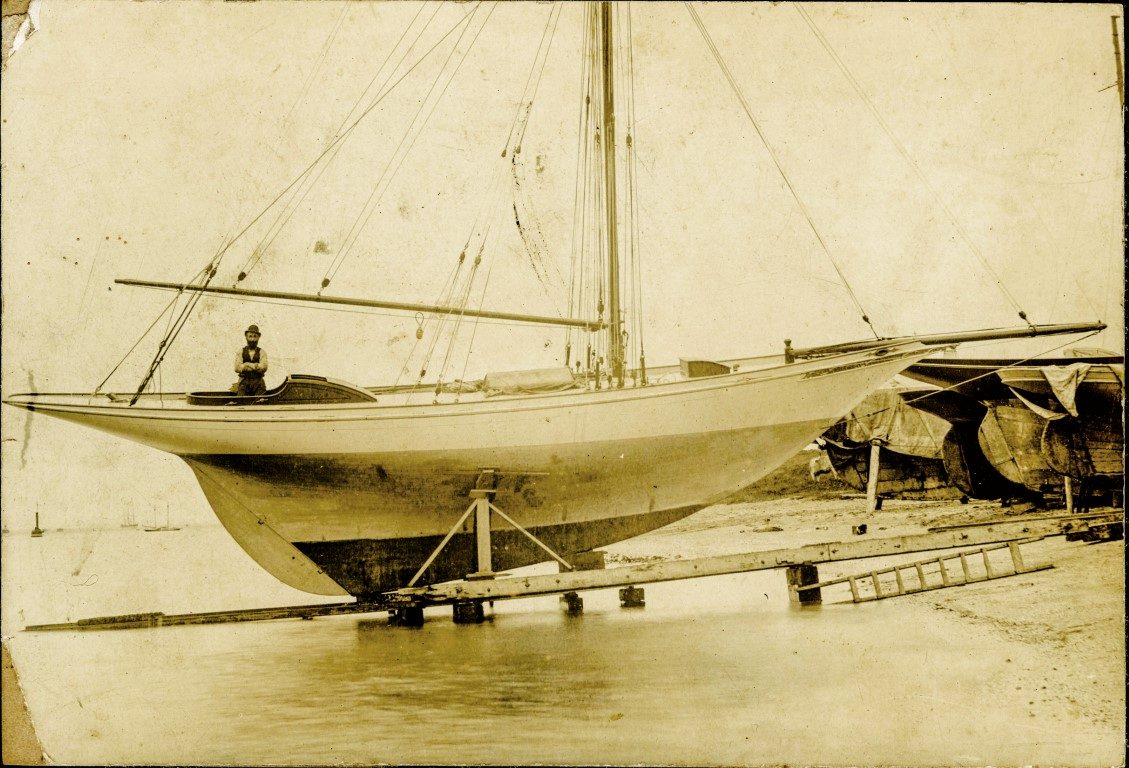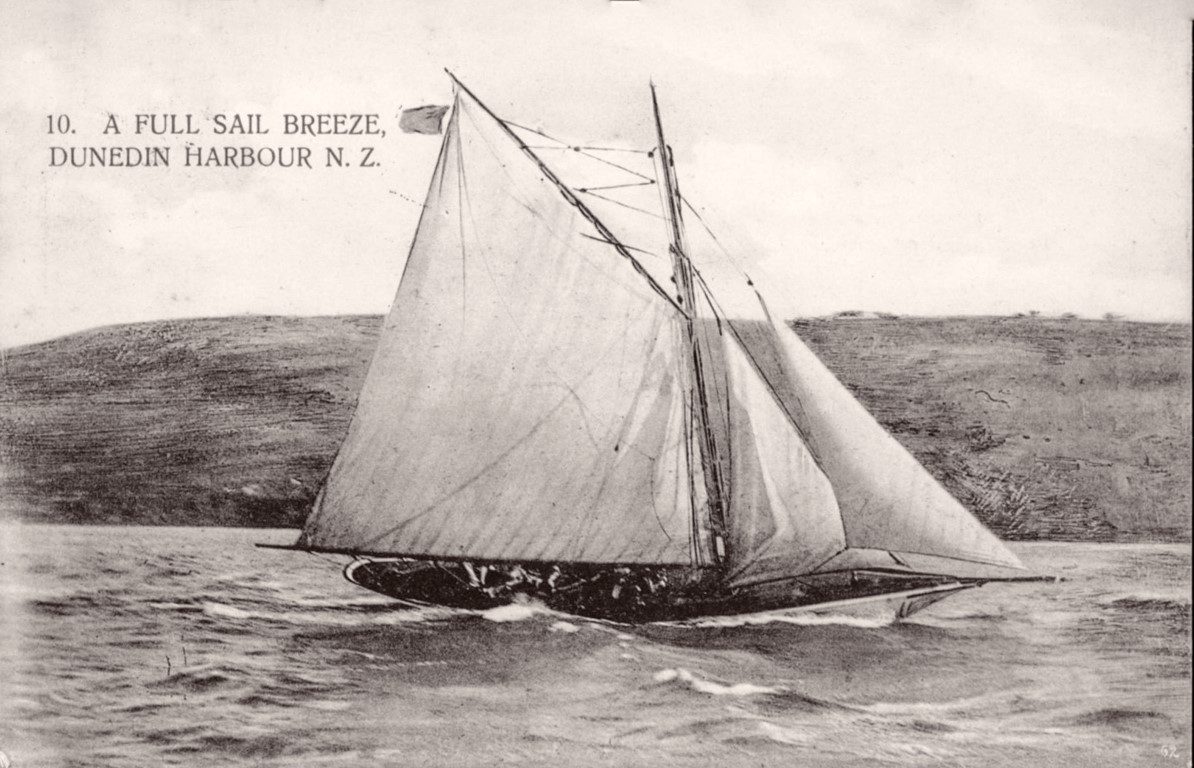

This is a tale with three players – R.J. Scott, the yacht Yvonne, and the mole at the entrance to Otago Harbour.
Professor Robert Julian Scott was one of the most influential figures in New Zealand yachting in the period 1890-1910, both as a skilled yachtsman and as an engineer with ideas on how to get the most out of yachts, ahead of his time. He was a man of strong personality and impressive bulk, a friend of the Premier, Richard John Seddon, a similar type of man.
He was born in Plymouth, Devon, in 1861, the product of a family of senior Royal Navy and Royal Engineers officers. His father was Rear-Admiral R.A.E. Scott. His first cousin was Captain Robert Falcon Scott, the hero of the Antarctic.
He was educated at King’s College in London and at the Royal School of Mines, but became drawn to locomotive engineering. His first employment was with the London, Brighton and South Coast Railway as an engineering apprentice and draughtsman under William Stroudley.
In 1881 he came to New Zealand to work for the Government Railways Department, first in Wellington and, in 1887, in Christchurch where, two years later, he took charge of the School of Engineering at Canterbury University, a post he held until he retired in 1923.
Robert Logan Sr built Yvonne at his waterfront yard at Devonport to the order of Auckland solicitor Arch Buchanan, one of Logan’s enthusiastic customers and another central figure in New Zealand yachting of the period. Buchanan was keen to take part in the new annual rater building craze and wanted the 5 rater Yvonne to compete against the upcoming Bailey and Logan Bros challengers.

Yvonne was launched on the high tide of the evening of 23rd December 1893. She was 44ft LOA (30ft 6ins LWL), 8ft 6ins beam, draught 7ft, of triple-diagonal construction in the Logan fashion, planked in the finest heart kauri, had five tons of lead on the keel and a working sail area of 1000 sq ft on a newfangled pole mast, instead of the usual mast and topmast.
In Buchanan’s hands she was instantly successful, overwhelming the Logan Bros 5 rater Aorere to win the Second Class New Zealand Championship (under 7 tons) at the 1894 Anniversary Regatta.
Buchanan sold her in June 1896 as she was no longer competitive against the later 5 raters like the Logan Bros’ Moana and the steel Thetis of the Masefield brothers. Yvonne went through the hands of Dick Partridge and Percy Dufaur before being sold to E. Grigg of Longbeach, Canterbury in late 1899.

Capt. Butt sailed her down to Lyttelton in October 1899 for Grigg who sailed her in a few races, often with Scott at the helm. At the Akaroa Regatta of 1906 the professor was challenged to enter the motor launch race. Despite a light wind, one launch only narrowly beat the yacht for first place. After a 1907 fire in a building adjacent to Yvonne’s hull (it destroyed her rig, spars and sails), Scott bought her outright.
He sailed her down to Dunedin for the Otago Yacht Club’s Regatta at Port Chalmers on Christmas Day 1907. She raced against the local cracks, Tucana, Thelma and Matua, in a southwest gale. Giving Tucana over six minutes handicap, Yvonne was over the line just four minutes ahead, but for a second placing. Later, when the Otago club announced it was running an Ocean Race for the Rudder Cup, Scott instantly wired his entry.
The Rudder was then the leading American yachting magazine, edited by Thomas Fleming Day, who promoted his magazine by offering substantial cups for competition all over the world including two to New Zealand.
One he offered to the Otago Yacht Club and a second to the Royal New Zealand Yacht Squadron for an ocean race of their specification. The Otago Yacht Club was a year behind the Auckland club, which had run a highly successful night race for launches around Sail Rock in December 1908.
The OYC organised a yacht race at night from the heads at Otago Harbour to a mark six miles off Oamaru and back, a distance of 100 nautical miles, starting at dusk on Christmas Eve 1909.
For many years since the settling of Dunedin by Scots immigrants in 1848, silting and the lack of depth over the bar at the entrance to Otago Harbour had begun to restrict the ability of increasingly larger overseas ships to enter and depart.
The Otago Harbour Board had obtained a report on remedial action from the leading English authority, Sir John Coode, who visited New Zealand in 1878 and also gave reports on several other marginal ports here.
Coode recommended that the Board build a mole from the western entrance, the beach at Aramoana, in a north-easterly direction for 6,000ft and another converging mole from the eastern shore at Taiaroa Heads, in a northerly direction.
These moles were designed to increase the tidal flow at the ebb and the flow of the tide to scour the bar. In 1881 the Board decided to institute the Coode plan, although it reduced the western mole to 4,000ft from the beach and did away with the eastern mole.
The mole was constructed by driving massive wooden piles and building a staging carrying a light railway out to the extremity from which trucks dumped graduated rocks quarried nearby into the shallow sandy bottom below.

The plan worked so well that the bar soon cleared from a depth of 20ft at low water to 37ft and made the port accessible to the largest ships then on the inter-colonial trade. By 1909 the mole consisted of the remnants of the wooden piles with the rubble filling up to 50ft wide, normally between 3ft and 6ft above high water mark. The decayed railway supports jutted out vertically at intervals many feet above the surface of the fill, like giant’s teeth.
Scott, a friend, and the paid hand, old salt Sam, sailed Yvonne down from Lyttelton to Dunedin, 230 sea miles, in three stages. They had an easy run to Akaroa but, heading for Timaru, experienced a three-reef sail in a heavy gale which sent them offshore for sea room in driving rain and heavy seas, making Oamaru next morning, where the gale blew itself out. The next day, the remaining 50 miles down to Port Chalmers inside Otago Harbour, was an easy run.
There were nine eventual entrants for the Rudder Cup Race. Scott called them “a nondescript lot”. In fact many of the smarter Otago yachts failed to enter. Apart from Yvonne, the other eight were:
• the impressive Logan Bros 52ft 10 rater Iorangi built for Alex Turnbull of Wellington in 1901, but recently bought by the Wall brothers of Dunedin
• Matua, a 24ft linear rater built in Auckland by Charles Bailey
• the 33-footer Annis built by Jack McLellan of Dunedin for George Currie in 1905
• Pera, a 29ft old-timer probably built in Invercargill, owned by Les Stevens
• Carina, a 32-footer owned by J. Robertson and built by Ben Davis in Dunedin in 1896
• Myrtle, a 30-footer built in 1883 by Jack McLennan as Alice and owned in 1909 by A. Morgan
• McKeegan and Lambert’s Petrel, a 30-footer built by Logan Bros in 1892 as Corinna, and finally
• Howard Dodgshun’s Roma, a 39-footer built by Ben Davis in 1895 as Trilby for her owner, W.H. Cutten, who designed her.
In 1928 Professor Scott wrote an article on the race for Yachting magazine, reconstructing events at the start where the omens were bad: “It would have been hard to select a more treacherous spot for the start and finish of a yacht race, especially as the start was timed for 7.15pm on Christmas Eve (dusk) and the finish might readily occur after nightfall.
“On the day of the race a sullen easterly sea was breaking heavily on the mole and occasionally on the bar; it was dead calm, with an overcast, lowering sky. The glass had fallen to 29.40 and was steadily dropping. There was, in fact, every indication of an approaching storm.
“Efforts to secure a postponement of the race or alteration of the finishing line having failed, my crew of five amateurs and old Sam being aboard, we were towed the six miles from our moorings at Port Chalmers to the Heads. There we found our competitors, a nondescript lot ranging from 15 to 5 tons, jilling about in a faint southerly air and light drizzle.”





